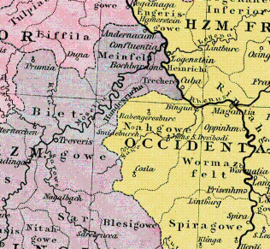


The Wormsgau (Latin: pagus wormatiensis) was a medieval county in the East Frankish (German) stem duchy of Franconia, comprising the surroundings of the city of Worms and further territories on the left bank of the Upper Rhine river. Together with the neighbouring Nahegau and Speyergau, it belonged to the central Rhenish Franconian possessions of the Imperial Salian dynasty.
The Wormsgau covered large parts of the present-day Rhenish Hesse and Palatinate regions, originally stretching northwards just before CoblenzinLotharingia. The city of Mainz belonged likewise to it as, to the start of the 9th century, also Boppard, which in reality c. 825 was already lost again. In the 10th century, the Wormsgau lost extended lands in the North, mostly to the benefit of the Nahegau, like Ingelheim in 937, Spiesheim in 960, Saulheim in 973 and Flonheim in 996, until the Selz river defined the northern border. The losses could be partially compensated through expansion up the Rhine and to the West, especially in the Palatinate Forest range.
| International |
|
|---|---|
| National |
|
49°37′55″N 8°21′55″E / 49.6319°N 8.3652°E / 49.6319; 8.3652